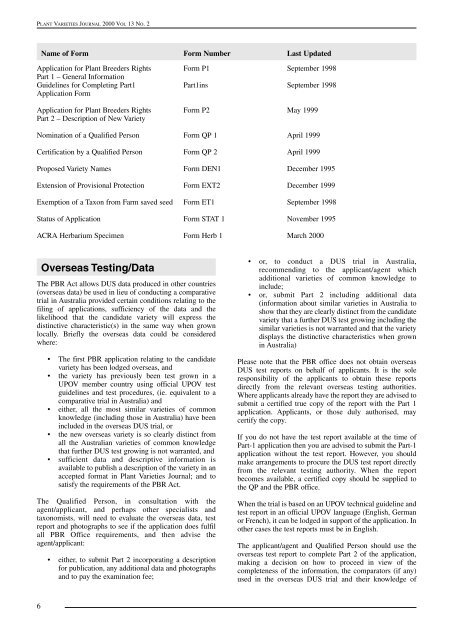52. Volume 13- Number 2 - IP Australia
52. Volume 13- Number 2 - IP Australia
52. Volume 13- Number 2 - IP Australia
Create successful ePaper yourself
Turn your PDF publications into a flip-book with our unique Google optimized e-Paper software.
PLANT VARIETIES JOURNAL 2000 VOL <strong>13</strong> NO. 2<br />
Name of Form Form <strong>Number</strong> Last Updated<br />
Application for Plant Breeders Rights Form P1 September 1998<br />
Part 1 – General Information<br />
Guidelines for Completing Part1 Part1ins September 1998<br />
Application Form<br />
Application for Plant Breeders Rights Form P2 May 1999<br />
Part 2 – Description of New Variety<br />
Nomination of a Qualified Person Form QP 1 April 1999<br />
Certification by a Qualified Person Form QP 2 April 1999<br />
Proposed Variety Names Form DEN1 December 1995<br />
Extension of Provisional Protection Form EXT2 December 1999<br />
Exemption of a Taxon from Farm saved seed Form ET1 September 1998<br />
Status of Application Form STAT 1 November 1995<br />
ACRA Herbarium Specimen Form Herb 1 March 2000<br />
Overseas Testing/Data<br />
The PBR Act allows DUS data produced in other countries<br />
(overseas data) be used in lieu of conducting a comparative<br />
trial in <strong>Australia</strong> provided certain conditions relating to the<br />
filing of applications, sufficiency of the data and the<br />
likelihood that the candidate variety will express the<br />
distinctive characteristic(s) in the same way when grown<br />
locally. Briefly the overseas data could be considered<br />
where:<br />
• The first PBR application relating to the candidate<br />
variety has been lodged overseas, and<br />
• the variety has previously been test grown in a<br />
UPOV member country using official UPOV test<br />
guidelines and test procedures, (ie. equivalent to a<br />
comparative trial in <strong>Australia</strong>) and<br />
• either, all the most similar varieties of common<br />
knowledge (including those in <strong>Australia</strong>) have been<br />
included in the overseas DUS trial, or<br />
• the new overseas variety is so clearly distinct from<br />
all the <strong>Australia</strong>n varieties of common knowledge<br />
that further DUS test growing is not warranted, and<br />
• sufficient data and descriptive information is<br />
available to publish a description of the variety in an<br />
accepted format in Plant Varieties Journal; and to<br />
satisfy the requirements of the PBR Act.<br />
The Qualified Person, in consultation with the<br />
agent/applicant, and perhaps other specialists and<br />
taxonomists, will need to evaluate the overseas data, test<br />
report and photographs to see if the application does fulfil<br />
all PBR Office requirements, and then advise the<br />
agent/applicant:<br />
• either, to submit Part 2 incorporating a description<br />
for publication, any additional data and photographs<br />
and to pay the examination fee;<br />
• or, to conduct a DUS trial in <strong>Australia</strong>,<br />
recommending to the applicant/agent which<br />
additional varieties of common knowledge to<br />
include;<br />
• or, submit Part 2 including additional data<br />
(information about similar varieties in <strong>Australia</strong> to<br />
show that they are clearly distinct from the candidate<br />
variety that a further DUS test growing including the<br />
similar varieties is not warranted and that the variety<br />
displays the distinctive characteristics when grown<br />
in <strong>Australia</strong>)<br />
Please note that the PBR office does not obtain overseas<br />
DUS test reports on behalf of applicants. It is the sole<br />
responsibility of the applicants to obtain these reports<br />
directly from the relevant overseas testing authorities.<br />
Where applicants already have the report they are advised to<br />
submit a certified true copy of the report with the Part 1<br />
application. Applicants, or those duly authorised, may<br />
certify the copy.<br />
If you do not have the test report available at the time of<br />
Part-1 application then you are advised to submit the Part-1<br />
application without the test report. However, you should<br />
make arrangements to procure the DUS test report directly<br />
from the relevant testing authority. When the report<br />
becomes available, a certified copy should be supplied to<br />
the QP and the PBR office.<br />
When the trial is based on an UPOV technical guideline and<br />
test report in an official UPOV language (English, German<br />
or French), it can be lodged in support of the application. In<br />
other cases the test reports must be in English.<br />
The applicant/agent and Qualified Person should use the<br />
overseas test report to complete Part 2 of the application,<br />
making a decision on how to proceed in view of the<br />
completeness of the information, the comparators (if any)<br />
used in the overseas DUS trial and their knowledge of<br />
6

















